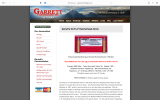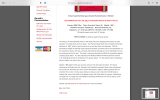Part of the problem right now in Canada, and I'm sure it is in your part of the world, is the availability of components, is a very big issue with getting into reloading these days. I also just really like guns and have the fantastic problem of not knowing which one to use! The 9.3's are old Husqvarnas, the 375 Ruger a Guide Gun, the 416 a Model 70 safari express, the 458 WM a Zastava that looks like it was made im high-school shop class. But the action feels solid and has a big steel claw. I have a custom HS precision PHL in 300 WSM as well. I wouldn't say I buy cheap rifles but I'm also not putting a Blaser in the scabbard on my horse and beating it off of 600-800 miles worth of trees and willows and constant rain for months at a time in the Yukon. If you could invest in the proper reloading supplies for the cartridges listed above, which one would you focus on?
Obviously it would have to be the one you ultimately choose as the best. But the question you asked was relative to reloading in Canada.
The 416 Would be the one most difficult to get generally. Though if your local shop has it, then off you go. Dies are more expensive, and bullets, and brass. Sometimes just unavailable. You can certainly find it, but while reloading is generally less expensive. It could be more expensive if your usual consumption was a box a year, and you might use up that much ammo just getting your preferred loads. I haven't personally seen 416 cases in bags, anywhere.
(THOUGH, for the use you have in mind, I would concentrate on getting the low standard, factory specs. I get the game, but in the real world if the 416 is not enough (?), you don't want to try to turn you 416 Remington into a Weatherby, you buy a Weatherby, or a Rigby. I am not recommending the upgrade, but a philosophy. So if you follow that rule of every cartridge that is fully loaded (not geriatric 45-70 loaded for 19th century guns), is kinda perfect as it is, and don't try to make it "better than it should be", then your time on the bench should be far less.)
The 458 WM is pretty easy to get, no 308, but easy enough. But it would be more expensive just because it has more of everything. And the dies can be twice as expensive, as they "should" be.
The larger the case the more you may run into a problem with a craptastic press that might handle 30-06, but might be tested with 458. I bought a Rochucker back when they were cheap, and for what it is, it is the best. But there are some smaller presses that are very economical , but I would need to ask some question about them for the larger stuff. So that might be a problem with a 458, don't know.
.375 is widely available, but in the current Canada, you may certainly run into a lot of "Sold out" signs for almost anything... But I would be reasonably confident in finding it. It is also the largest case that PRVI sells. PRVI is a mid price and quality case that is standard in Europe.
At this point the 9.3x62 is the clear winner, it is natively cheaper, being the smallest cartridge, and it is strangely highly available in Canada. You can even get cast bullets for it. PRVI stock both bullets and brass for it. The bullets get mixed report, I think they might be a bit like a Sierra cup bullet. Where I am they could kill either my Black Bear, or Moose if the nose fell off on the way to the target. For Grizz I would also load Nosler, and some Mono, depending on what you expect. Or Barnes TSX, based on what the old hands say is best. But the PRVI is great for practice, etc... For PB, I have no real knowledge, but solids will certainly do it, if one can place the bullets.
While it represents a case separation hazard in theory (see below), you can reload either 30-06, or 35 Whelen, for 9.3. That appeals to me given our current flirtation with the illogical, innumerate, and inexperienced in Ottawa. (The case separation deal is because the head is smaller on 30-06 ammo, and that is a part one does not want to mess with, however, someone did the obvious and measure the two heads, and found they were identical, so perhaps whatever manufacturer was the source of those cases had already taken the shortcut.) In a world where the UK bans wood stoves, one never knows what essentials of life will be banned next.
Re, your Zastava:
A lot of pros that shoot bolts have customized their wood stocks. Wood is great for that because it is strong enough to allow manipulation, and addition; can be sealed with epoxy and be basically as weatherproof as plastic. And it is stiffer than most synthetic stocks, which is great for shooting. So the pro approach is to Bondo it into a correct shape, make any changes that you need for a proper cheek weld, and length of pull. Then seal it up, glass bed it. put on pro positioned sling hardware, or not. Then you either leave it looking very messy, because that is a sort of humble brag, or you give it a paint job.
Here is an interesting piece on the 9.3. As always one has to filter through guide vs client issues.


